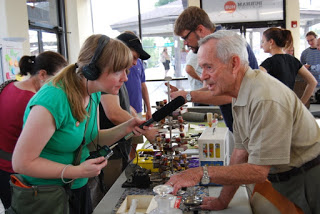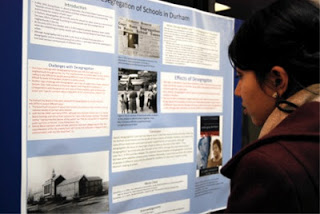
Recent posts on the CFM Blog on pop-up museums & exhibits have provoked a lot of interest, so I invited Katie Spencer, executive director of the Museum of Durham History, to contribute yet another perspective. Her museum, still under development, is using pop-up events as a form of rapidproto-typing—a low cost, low risk way of trying out concepts, forging relationships with partner organizations, and building community engagement before the museum even opens.
The Museum of Durham History is a young museum in Durham, North Carolina. Because we are new, much of what we do is an experiment. We’ve seen local history museums in our state and region struggle and sometimes fold, so we feel obligated to look at new, experimental models for museums to ensure our success. We have the advantage of building a new museum in a time when many museums are re-evaluating their institutional histories and trying to think of new ways forward.
One thing we have been experimenting with is pop-up museums. We were inspired by Michelle DelCarlo’s pop-up museum concept, seeing it as a low-tech way to create engagement and conversation, both of which are critical to our museum’s long-term success. Conversations such as those spawned by a recent CFM post on museum pop-ups suggest that other museums are interested in experimenting with this model as well.
Our emerging history museum is very much in a start-up phase and has only recently leased a small building to use as our first museum space, called the History Hub. We were initially attracted to pop-up museums as a way to kick-start conversations about the past in our community. Pop-ups provided a way to bring people, objects, and stories to the History Hub, even before we install exhibits, by creating a museum experience complete with objects, community voices, and visitor engagement in what is currently an empty building. In Durham there is no central historical collection, and so the pop-up museum model also creates opportunities for us to discover and document objects that are valuable to our community’s understanding of the past.
 |
|
A Durham druggist shares stories about growing up in town
and working at the family drug store at the
Tools of the Trade Pop-up Museum.
|
Our first pop-up took place at the History Hub as part of a weekend-long outdoor festival in downtown Durham. We selected the theme and format through conversations with staff, volunteers, and community members. I really like Michelle’s focus on universal themes and emotions (e.g. “hope”), but I discovered that people had a hard time relating these concepts to their understanding of history. They responded better to more tangible topics, so in the end we focused our first pop-up on an object-based theme: “tools of the trade.” We encouraged people to interpret “tools” to be anything used to get a job done, from cooking to factory work to art to public safety. Twelve people brought personal or family objects to share, over 200 people came through our doors to see the pop-up in progress, and a photographer and an audio documentarian captured the stories that were shared.
This first pop-up museum was on the whole a wonderful experience, but getting people to participate took more work than we expected. Because we were worried that no one would show up, we made many calls inviting people to bring pieces of their collection or their family history. In the end only one of the people who brought objects did so without a personal invitation from museum staff.
 |
| A visitor reads about desegregation of Durham schools at a Pop-up Museum created by students from Duke University and N orth Carolina Central University |
As we develop more pop-up museum events, we find they work best for us when conducted in partnership with other community groups. In a few months we will collaborate with Durham’s North Carolina Mutual Life Insurance Company, the oldest and largest African American life insurance company in the country. In celebration of the company’s 115th anniversary, the museum and the company will invite current employees, past employees, and descendants of past employees of NC Mutual to bring in photos, stories, and objects from their time with the company. Later in the year we will conduct a pop-up museum on Durham’s Jewish history in conjunction with a program at the Durham County Library. We’ve also conducted a pop-up museum featuring mini-exhibits made by students at nearby Duke University and North Carolina Central University. All these partners link the museum to members of the community with interesting perspectives on history and help ensure broader participation. We conducted two pop-up museums in 2012 and have four planned for 2013. I suspect that the challenge will continue to be driving participation: we need to convince people that their perspective on Durham’s past is interesting and significant enough to be in a museum, even if only for one day.
Recent efforts on the part of museums to build community participation is a wonderful step in the right direction, but it may be easier for those of us who spend a lot of time thinking about museum models—past, present, and future—to embrace that goal, than it is for people who see museums as less central to their everyday lives and who may think of museums as a place one visits to be told about the past (or about science, art, etc.). Pop-up museums have proved to be a simple way for the Museum of Durham History to communicate our vision of the importance of community participation and each event measure of how successfully we have shared that vision.
Our pop-up museums, each with its unique theme and community partner, have functioned as experiments in community involvement. Because these pop-ups are so simple, so economical, and so flexible, we can afford to experiment in this way, and what we learn from these experiments helps us plan for our museum-in-progress.
Katie notes that she is very interested in finding other community history museums that are experimenting with new ideas. If you can help her find such projects, please share information and links in the comment section, below.









It's wonderful to hear Katie's experience, and I am so happy to see how the pop-up museum experience is inspiring others.
If it's helpful, I've created a Pop-Up Museum Blueprint and Evaluation Instrument, available on the blog under Tools. Hopefully these will be of assistance to others who are creating their own pop-up museums.(http://popupmuseum.blogspot.com)
I truly believe in the power of being in conversation and partnership with our communities, so let's keep going!
Museum exhibition design in india. SK Pahari is one of the best museum exhibition design company in delhi, india. VIEW MORE :- Museum exhibition design